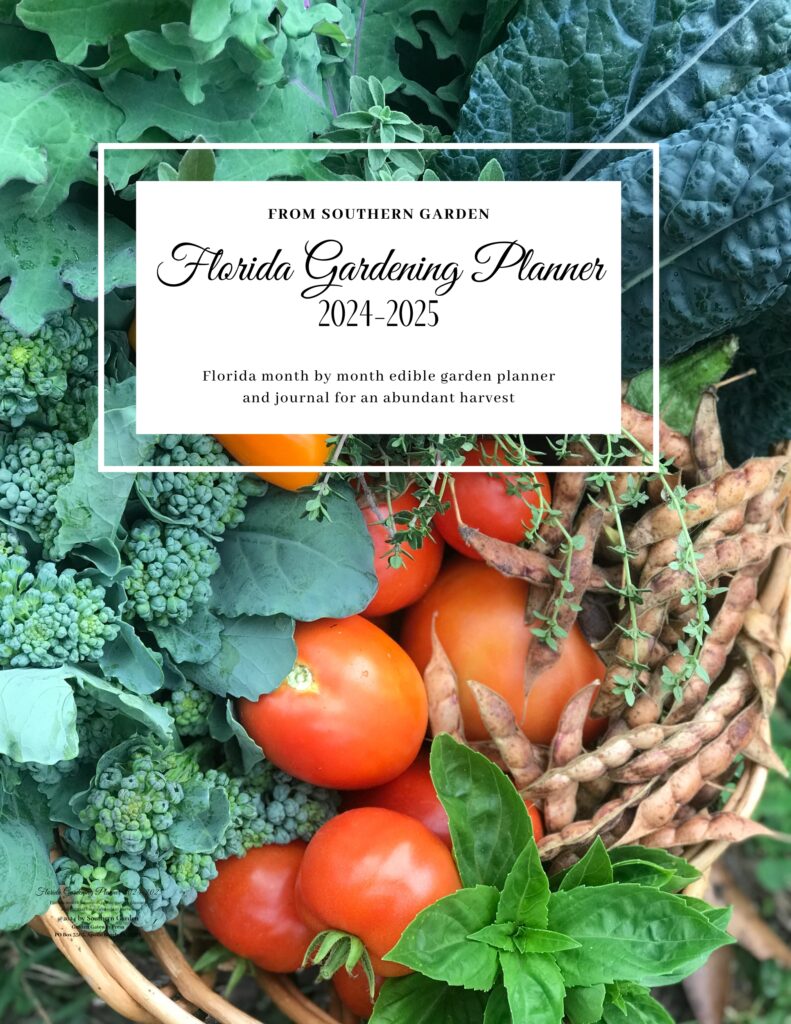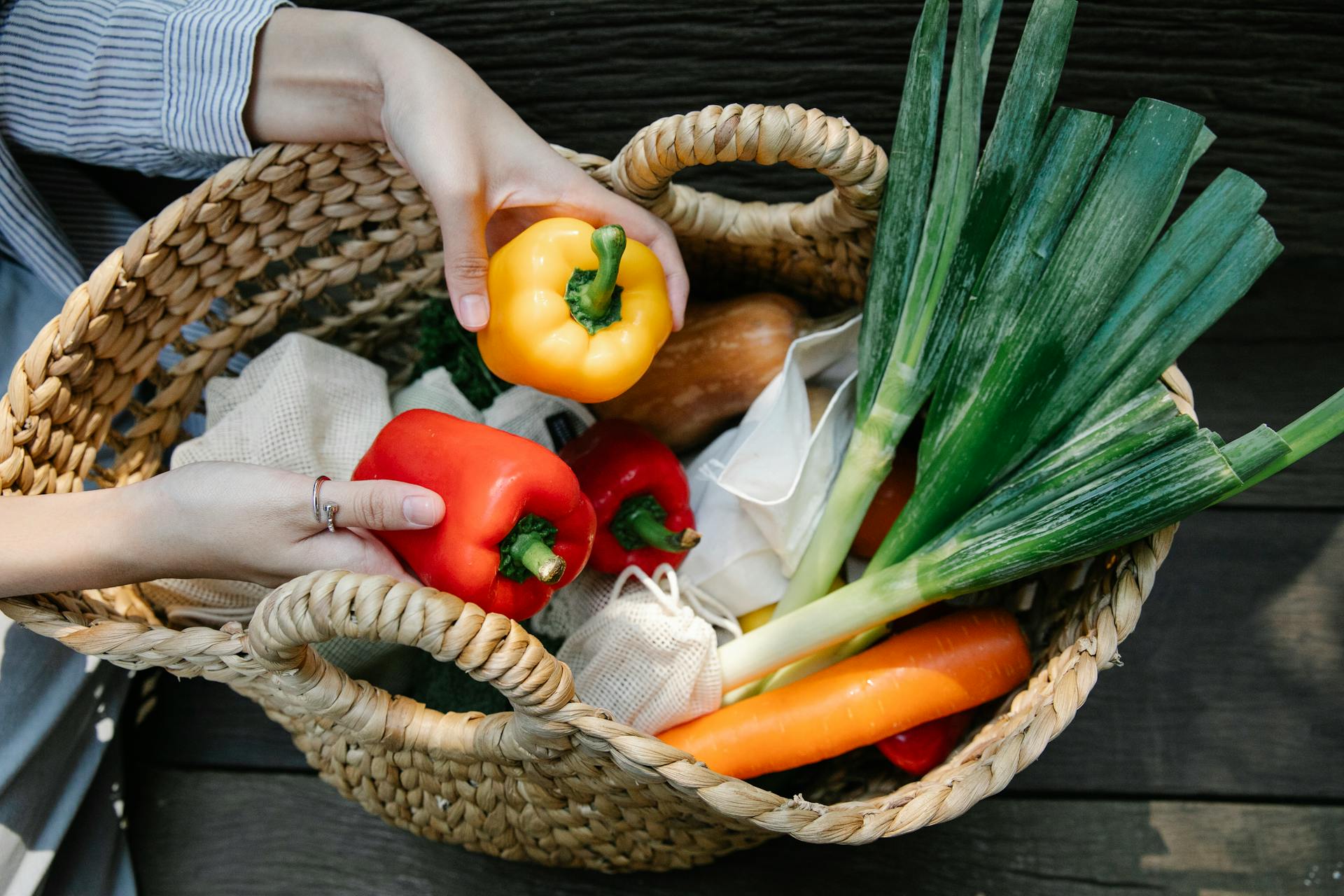
Florida’s climate, with its sunny days and mild winters, offers an excellent opportunity for growing fresh, healthy vegetables year-round. A container vegetable garden is an especially convenient for Floridians.
Using containers is an adaptable way to cultivate your favorite veggies, whether you live in a high-rise apartment, have limited yard space, or simply prefer the flexibility of moving plants to the best light or shade.
It’s also one way many gardeners can insure quality soil, despite our nutrient-poor and sandy soils.
With the right techniques, container-grown vegetables can thrive in Florida’s unique conditions, producing abundant harvests for your table.
Why Choose a Container Vegetable Garden?
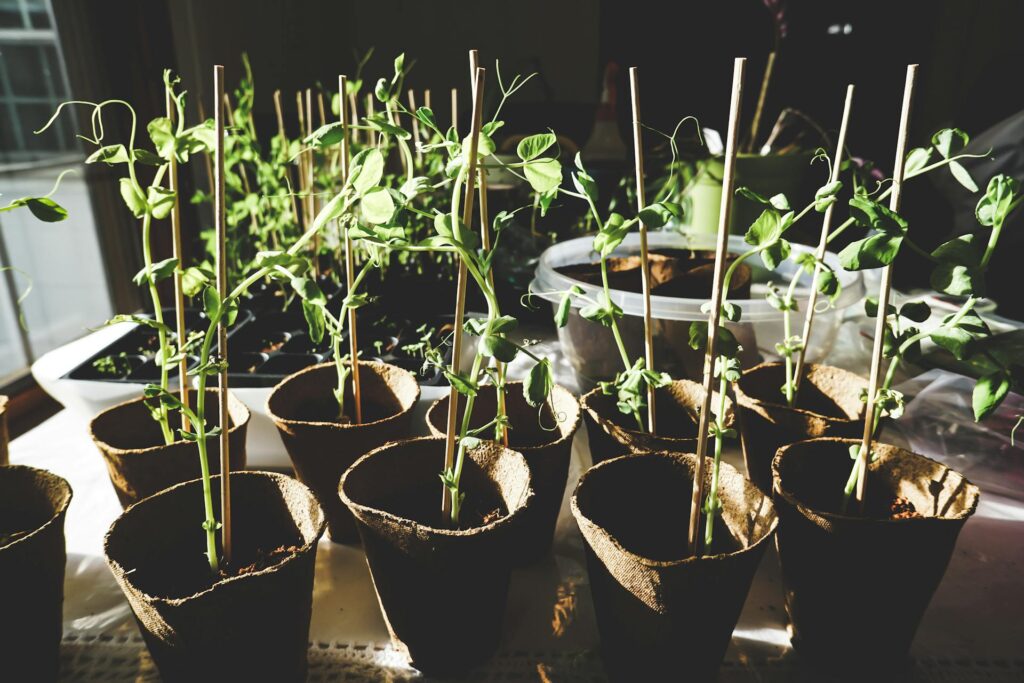
Adaptability to Space Limitations
Container gardening is perfect for gardeners without a large backyard. You can grow vegetables on patios, balconies, or even indoors near a sunny window. This flexibility makes fresh produce accessible no matter where you live.
Control Over Soil Quality
Florida’s native soils can range from sandy and nutrient-poor to heavy and waterlogged. By growing in containers, you can use high-quality potting mixes tailored to your vegetables, ensuring optimal growth conditions.
Mobility for Sun and Weather Protection
Containers allow you to move your plants to chase the sun during shorter winter days or provide shade during the intense summer heat. Additionally, you can bring containers indoors or to sheltered areas during Florida’s unpredictable storms or rare cold snaps.
Reduced Pest Issues
Growing vegetables in containers elevates them off the ground, making them less accessible to certain pests like nematodes and soil-borne pathogens. This can lead to healthier plants and better yields.
Water and Fertilizer Efficiency
Containers let you deliver water and nutrients directly to the roots, reducing waste and runoff. With proper care, a container vegetable garden often grows faster and more vigorously than their in-ground counterparts.
Container Requirements for Florida Vegetable Gardens
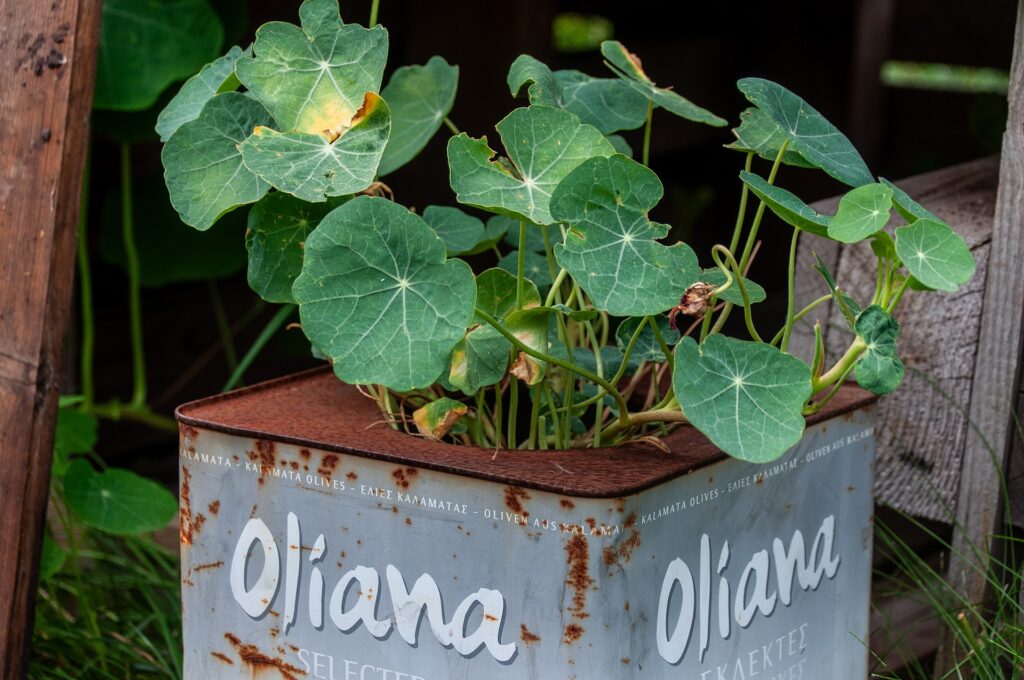
Success in container gardening begins with proper setup. Florida’s unique climate calls for thoughtful choices in containers, soil, and placement. Here’s what you need to know:
Choosing the Right Container
Selecting the right container is essential for healthy vegetables in Florida’s conditions.
Size Matters: Most vegetables need containers at least 12 inches deep to accommodate their roots. Larger vegetables like tomatoes or peppers thrive in containers closer to 18 inches deep.
Drainage is Key: Look for containers with multiple drainage holes to prevent waterlogging, which can lead to root rot, especially during Florida’s rainy season. If your container lacks sufficient drainage, consider drilling extra holes.
Temperature Control: Light-colored containers are ideal for keeping roots cooler in the summer, reflecting heat rather than absorbing it. In cooler winter months, darker containers can help retain warmth for year-round growing.
Self-Watering Containers: Consider self-watering containers for vegetables that require consistent moisture, such as leafy greens or cucumbers. These systems reduce watering frequency and help prevent soil from drying out in the summer heat.
Soil and Drainage
The right soil mix ensures strong, productive plants in containers.
Use Quality Potting Soil: A lightweight, well-draining potting soil designed for vegetables provides the nutrients and structure plants need. Avoid using garden soil, which can compact in containers and lead to poor aeration.
Enhance with Additives: To help retain moisture during Florida’s scorching summers, consider mixing in moisture-retaining crystals or organic materials like coconut coir. These additions prevent your plants from drying out too quickly.
Focus on Drainage: Incorporate materials like perlite or coarse sand into your potting mix to further improve drainage, ensuring that your vegetables don’t sit in soggy soil.
Positioning and Protection
Proper placement and care can make or break a container vegetable garden in Florida’s challenging weather.
Maximize Sunlight: Place containers in a location that receives 6-8 hours of direct sunlight daily, such as a sunny patio or south-facing balcony.
Mobility for Protection: Use containers with built-in wheels or invest in plant caddies for larger pots. This mobility allows you to easily move plants during storms, Florida’s summer downpours, or even chilly winter nights.
Shade During Heat Waves: During the peak of summer, vegetables may need afternoon shade to avoid overheating. Use shade cloths or position containers under an awning or tree during the hottest part of the day.
Microclimate Benefits: Group containers together to create a microclimate, which helps retain humidity and shields plants from drying winds. This setup is especially useful during Florida’s dry spring months.
Top 10 Plants for Your Container Vegetable Garden
Here are my recommendations for the top 10 vegetables for container gardens to grow in your Florida landscape. These recommendations are based on the plants’ size and ability to deliver in container conditions:
1. Cherry Tomatoes: A Container Garden Favorite
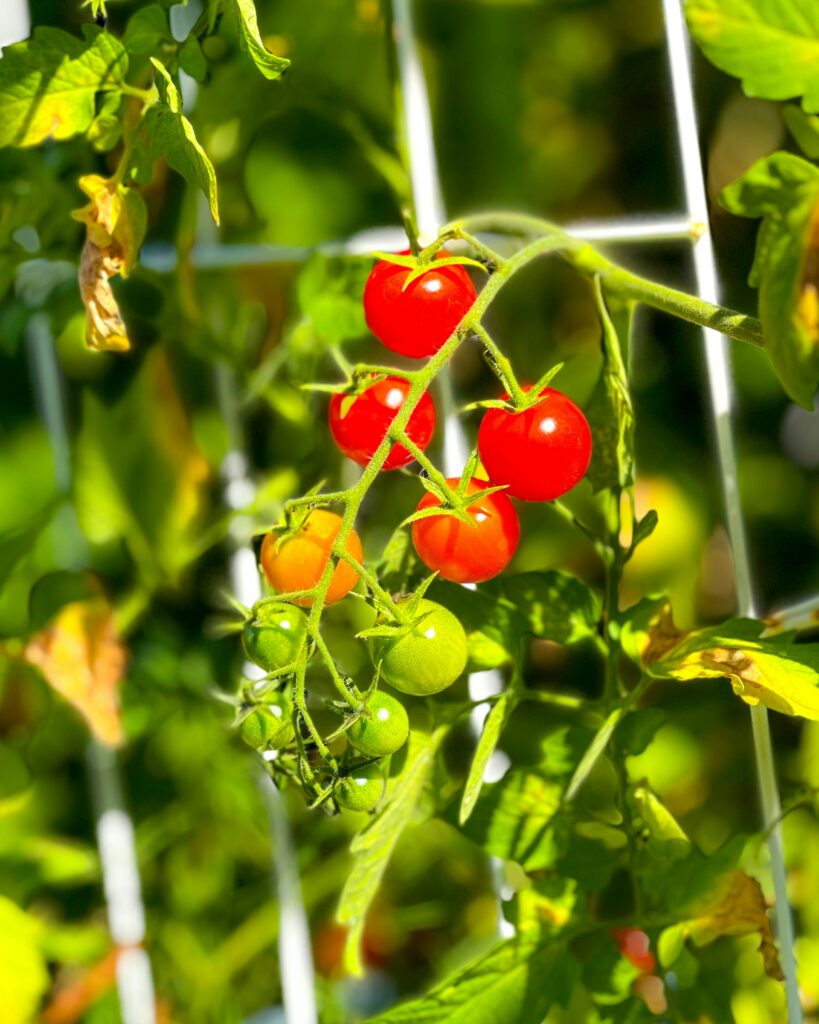
Cherry tomatoes are among the most rewarding vegetables to grow in containers. Their compact growth habit and continuous fruit production make them ideal for Florida’s unique climate.
Best Varieties
- ‘Sweet 100’: Prolific producer with sweet, bite-sized fruits.
- ‘Everglades’: Native to Florida, this variety thrives in heat and humidity.
- ‘Sun Gold’: A gardener favorite for its vibrant orange fruit and tangy-sweet flavor.
Container Size: Choose a container with a minimum 5-gallon capacity to provide ample room for the plant’s roots. Ensure the container has adequate drainage holes to prevent waterlogging.
Growing Tips
Support System: Install a tomato cage, stake, or trellis at planting time to avoid damaging roots later. Cherry tomatoes are vigorous climbers and need proper support to stay healthy and productive.
Prune Suckers: Regularly remove the small shoots (suckers) that grow between the main stem and branches. This helps direct energy toward fruit production. This step is not neccessary with ‘Everglades’ tomatoes, however.
Watering: Water deeply to encourage strong root development, but take care to avoid wetting the leaves, which can lead to fungal issues. Allow the top inch of soil to dry out between waterings.
Common Issues
Leaf Roll: In intense heat, cherry tomato leaves may curl to conserve moisture. This is often a sign of stress but not necessarily harmful. Move containers to a location with light afternoon shade during extreme heat to minimize stress.
Blossom Drop: High temperatures can cause flowers to fall off before setting fruit. Keep plants well-hydrated and provide some shade to improve fruit retention.
Pests: Monitor for common pests like whiteflies or aphids. Treat infestations with insecticidal soap or neem oil, ensuring applications occur in the early morning or evening to prevent leaf burn.
2. Bush Beans: A Compact and Productive Choice
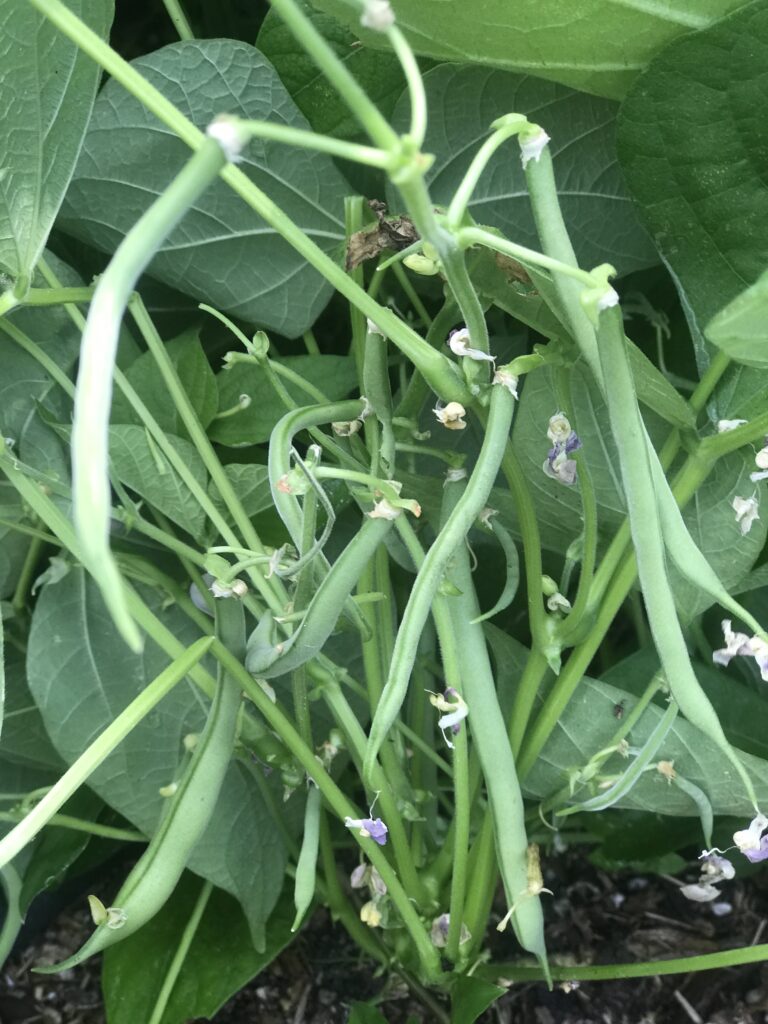
Bush beans are an excellent option for container gardens, offering quick growth and abundant harvests. These heat-tolerant plants are easy to care for and ideal for small spaces.
Recommended Varieties
- ‘Contender’: A reliable, early-producing variety with tender pods.
- ‘Provider’: Known for its disease resistance and high yields, even in challenging conditions.
Container Requirements: Select a container that is at least 2-3 gallons in size and a minimum of 6 inches deep. Bush beans don’t require extensive root space, making them well-suited to smaller pots or window boxes. Ensure the container has multiple drainage holes to avoid waterlogged roots.
Growing Success
Succession Planting: To enjoy a continuous harvest, sow new seeds every 3 weeks throughout the growing season. This staggered planting approach ensures fresh beans over an extended period.
Consistent Moisture: Beans thrive in evenly moist soil. Use a watering schedule to prevent the soil from drying out completely or becoming overly saturated. A layer of mulch can help retain moisture during hot weather.
Frequent Harvesting: Pick pods regularly once they reach the desired size. Frequent harvesting encourages the plant to produce more beans and prevents pods from becoming tough or stringy.
Pest Management
Aphids: These small insects can cluster on leaves and stems, sucking sap and weakening the plant. Use a strong stream of water to dislodge them or apply insecticidal soap if the infestation persists.
Ants: Ants often appear when aphids are present, as they feed on the honeydew aphids produce. Address the ant problem to reduce aphid activity.
Fungal Issues: Ensure proper air circulation by spacing plants adequately and avoiding overhead watering to reduce the risk of fungal diseases.
3. Bell Peppers: Sweet and Versatile

Bell peppers thrive in Florida’s heat when grown in containers, producing colorful, sweet fruits that are perfect for cooking or fresh eating. With proper care, they can yield abundantly even in challenging conditions.
Heat-Tolerant Varieties
- ‘California Wonder’: A classic variety known for its blocky, thick-walled fruits.
- ‘Big Bertha’: Produces extra-large, sweet peppers that mature quickly in warm climates.
Container Specs: Each bell pepper plant requires its own 3-5 gallon container to ensure sufficient root space and stability. Containers should have multiple drainage holes to prevent waterlogging.
Care Guidelines
Calcium-Rich Fertilizer: Feed plants with a fertilizer high in calcium to prevent blossom end rot, a common issue with peppers. Look for fertilizers labeled as “tomato and vegetable” formulas with added calcium.
Fruit Support: As peppers grow and fruit begins to develop, their stems may need support. Use stakes, small cages, or plant ties to keep heavy branches upright.
Moisture Management: Water consistently to maintain even soil moisture. Avoid allowing the soil to dry out completely, as fluctuations in moisture can lead to stress and reduced fruit production.
Disease Prevention
Air Circulation: To reduce the risk of fungal diseases, place containers with adequate spacing to ensure airflow between plants. Avoid overcrowding and prune excess foliage if necessary.
Watering Technique: Water at the base of the plant rather than overhead to keep foliage dry, minimizing the risk of fungal infections.
Mulching: A thin layer of mulch on the soil surface can help maintain moisture and reduce the risk of soil-borne diseases splashing onto the plants.
4. Eggplants: Beautiful and Productive

Eggplants are a great choice for Florida container gardening, combining striking foliage with edible fruits that thrive in warm weather. These versatile vegetables are as decorative as they are delicious.
Florida-Friendly Options
- ‘Black Beauty’: A classic, large-fruited eggplant variety that performs well in Florida’s climate.
- ‘Chinese Bride’: A slender, pale-lavender variety that matures quickly and produces prolifically.
Growing Requirements
Container Size: Use a minimum 5-gallon container for each plant to provide ample root space.
Location: Place in a full sun area where plants can receive at least 6-8 hours of direct sunlight daily.
Soil: Use rich, well-draining potting soil mixed with compost or a slow-release fertilizer to ensure consistent nutrients.
Maintenance
Branch Support: Eggplants produce heavy fruits that can weigh down branches. Use stakes, tomato cages, or plant ties to prevent breakage.
Watering: Keep the soil consistently moist but not waterlogged. Eggplants are sensitive to drought stress, which can reduce fruit size and quality.
Pest Watch: In dry conditions, spider mites can become a problem. Regularly mist plants or rinse the undersides of leaves to discourage infestations. Inspect for other common pests, like flea beetles, and treat promptly if found.
5. Loose-Leaf Lettuces: Crisp Greens for Florida’s Cool Seasons

Loose-leaf lettuces are a fast-growing, rewarding choice for Florida container gardeners. They thrive in the cooler months and offer continuous harvests with proper care.
Heat-Resistant Varieties
- Black-seeded Simpson: A classic, tender variety known for its rapid growth.
- Oak Leaf: Attractive, deeply lobed leaves that resist bolting in mild heat.
- Mesclun Mix: A blend of baby greens that includes lettuces, arugula, and other cool-season favorites.
- Red Sails: Adds a pop of color with its reddish-bronze leaves while tolerating mild heat.
Growing Success
Season: Plant from fall to spring and even through the winter for the best results in Florida’s climate.
Harvesting: Snip outer leaves regularly to encourage new growth and extend the life of the plant. For a larger yield, avoid cutting into the plant’s central crown.
Watering: Keep soil consistently moist to prevent stress, which can lead to bitter-tasting leaves.
Extended Season
Shade Cloth: Use lightweight shade cloth in early fall or late spring to reduce sun intensity and delay bolting as temperatures rise.
Container Placement: Position containers in a spot that receives morning sun and afternoon shade as the weather warms.
Mulching: Apply a thin layer of organic mulch to retain soil moisture and keep roots cool.
6. Bush Cucumbers: Crisp and Compact for Containers

Bush cucumbers are an excellent choice for Florida container gardens, offering prolific yields in a relatively small footprint. These compact varieties are ideal for growing in tight spaces with the right setup and care.
Compact Varieties
- Spacemaster: A compact variety designed for containers, producing sweet, crisp fruits.
- Bush Champion: Known for its high yield and adaptability to smaller spaces.
Container Setup
Size: Use a sturdy 5-gallon container to allow roots adequate space.
Trellis Support: Even bush varieties benefit from a small trellis or cage to keep vines off the ground and improve airflow.
Soil: Fill with nutrient-rich, well-draining potting soil mixed with compost.
Light: Position in full sun to encourage vigorous growth and fruiting.
Care Tips
Watering: Keep soil consistently moist but not soggy; cucumbers are particularly sensitive to drought stress.
Fertilization: Feed with a balanced vegetable fertilizer every 2-3 weeks during active growth.
Harvesting: Pick fruits regularly while they are still small to avoid bitterness and encourage continued production.
7. Spring Onions: Easy to Grow in Containers with Quick Harvests

Spring onions are a fantastic option for container gardening in Florida. Their compact growth and ability to regrow from root bulbs make them a great addition to any small garden or patio setup.
Container Varieties
- White Lisbon: A popular variety, offering mild-flavored onions that are perfect for early harvests.
- Evergreen Hardy: A cold-tolerant variety that can grow year-round in Florida’s mild winter climate.
- Red Baron: Adds color to your container garden with its vibrant red stems and mild taste.
Growing Success
Container Size: Use a wide, shallow container, like a window box planter, to allow room for the bulbs to spread out. A 12-18 inch wide container works well.
Soil: Use light, well-draining soil enriched with organic matter. Spring onions don’t need deep soil but require good drainage for healthy roots.
Light: Ensure your container is placed in full sun for at least 6 hours a day. Onions thrive in sunny spots with plenty of warmth.
Regrowing: After harvesting, save the root bulbs and replant them to regrow new spring onions in the same container. This provides continuous harvests.
Pest Resistance
Spring onions are naturally resistant to most pests due to their strong scent. However, be mindful of soil-borne diseases and keep containers well-drained to prevent rot.
8. Radishes: Fast-Growing and Ideal for Your Florida Container Vegetable Garden

Radishes are an excellent choice for container gardens in Florida due to their rapid growth and ability to thrive in cooler months. They can be harvested in as little as 3 to 4 weeks, making them a great option for gardeners looking for a quick return on their efforts.
Container Requirements
Container Size: Use a wide, shallow container, at least 6 inches deep. Radishes have relatively shallow roots, so a container with plenty of surface area is ideal.
Soil: Plant in a rich, loose soil mix. Radishes prefer soil that is well-draining, airy, and slightly sandy to allow for easy root development. Avoid heavy, clay-based soils that can hinder root growth.
Drainage: Make sure the container has sufficient drainage holes to prevent waterlogging, which can lead to root rot.
Growing Period
Planting Time: Radishes grow best in cooler weather, so plant from fall through late spring in Florida, avoiding the peak of the summer heat.
Growing Tips: Radishes thrive in temperatures between 55°F and 75°F (13°C to 24°C), making them ideal for Florida’s late fall and winter gardening seasons. Direct sow seeds into the container about 1/2 inch deep, and space them 1 to 2 inches apart.
Watering: Keep the soil consistently moist, especially during the growing period, but avoid waterlogging the container.
Radishes are one of the easiest and most rewarding vegetables to grow in Florida containers. They don’t require much space, and with a little attention to soil and watering, you can enjoy a fresh harvest in just a few weeks.
9. Hot Peppers: Spicy and Thriving in Florida Containers

Hot peppers are perfect for container gardening in Florida, where the warm climate helps them grow abundantly. These plants not only provide a steady supply of spicy fruits but also bring vibrant color and texture to your garden.
Florida Favorites
- ‘Datil’: A Florida native known for its fiery heat and distinctive flavor, perfect for making hot sauces and salsas.
- ‘Bird’s Eye’: A small, super-hot pepper variety commonly used in Southeast Asian cooking.
- ‘Habanero’: Known for its intense heat and fruity flavor, the habanero pepper is popular in many spicy dishes.
Container Needs
Container Size: Choose a 3-gallon container at a minimum for each plant. Larger containers can accommodate the pepper’s root system as it grows.
Drainage: Ensure excellent drainage, as peppers do not like their roots sitting in water. Make sure the container has multiple drainage holes to prevent root rot.
Soil: Use a well-draining, rich potting mix with a slightly acidic to neutral pH. Consider mixing in some compost for extra nutrients.
Care Tips
Sunlight: Hot peppers love the sun! Ensure they get at least 6-8 hours of full sun each day to thrive and produce fruit.
Watering: During the early stages of growth, keep the soil consistently moist. However, reduce watering once the fruits begin to ripen to avoid excess moisture, which can dilute the pepper’s heat and flavor.
Fertilization: Feed your peppers with a balanced fertilizer, but avoid excessive nitrogen, which can promote lush foliage at the expense of fruit production.
Hot peppers are a great addition to your Florida container garden, providing not only a bounty of heat-packed fruit but also a visually striking presence. With proper care, you’ll have fresh peppers ready for harvest throughout the growing season.
10. Culinary Herbs

Herbs are a fantastic addition to any container vegetable garden, especially in Florida’s climate. Not only do they thrive in pots, but they also provide fresh flavors for your kitchen. Here are some popular herbs to grow in containers:
Basil
Basil thrives in full sun and well-drained, fertile soil. It prefers warmer temperatures, making it a great choice for Florida. Pinch back flowers to encourage bushier growth and prevent it from becoming leggy.
Container Size: 1-3 gallon pots
Care Tips: Regular trimming promotes bushy growth. Keep it moist but not soggy. Basil can be sensitive to cold, so harvest before temperatures drop too much in the winter.
Oregano
Oregano loves the heat and does well in full sun. It requires little maintenance, as it tolerates dry conditions once established. However, it thrives with occasional watering and occasional fertilizing.
Container Size: 1-3 gallon pots
Care Tips: Oregano is a perennial herb that grows back year after year. Be sure to prune it regularly to prevent it from getting too leggy, and keep it in a sunny spot for the best flavor.
Rosemary
Rosemary loves full sun and well-drained soil. It is drought-tolerant once established, making it perfect for Florida’s heat. Plant in a container with excellent drainage to prevent root rot.
Container Size: 3-5 gallon pots
Care Tips: Trim regularly to prevent it from becoming too woody. If grown in pots, rosemary benefits from regular feeding with balanced fertilizer.
Cilantro
Cilantro grows quickly in cool weather, making it ideal for Florida’s fall and winter months. It prefers well-drained soil and full sun to part shade.
Container Size: 1-3 gallon pots
Care Tips: Cilantro bolts (goes to seed) quickly in hot weather, so it’s best to grow it in the cooler months. Keep the soil consistently moist but not soggy, and harvest leaves before it flowers to maximize flavor.
Marjoram
Marjoram prefers full sun and warm temperatures, similar to oregano. It thrives in containers with well-drained soil, which allows its delicate leaves to develop their signature sweet flavor.
Container Size: 1-3 gallon pots
Care Tips: Regular trimming helps marjoram stay compact and healthy. While it’s drought-tolerant once established, occasional watering helps maintain flavor. Protect it from excessive rain, which can cause mildew.
Sage
Sage is a hardy herb that loves full sun and thrives in well-drained soil. It can tolerate heat and drought once established, but it does best with only occasional watering. In fact, it’s a good idea to keep it (and rosemary) under cover during the summer rainy season to prevent disease.
Container Size: 3-5 gallon pots
Care Tips: Keep sage trimmed to prevent it from becoming leggy. You can also harvest it year-round, but avoid over-watering. Sage also appreciates a little protection during Florida’s occasional cold snaps.
These herbs are great for Florida container gardens, offering not only culinary benefits but also aromatic beauty. They work well in small pots and require minimal care once established, making them perfect for container gardening in Florida’s unique climate. Enjoy adding them to your garden and your meals.
Essential Care Tips for Success with Your Container Vegetable Garden

Growing vegetables in containers can be incredibly rewarding, but ensuring their health and productivity requires a bit of attention to detail. Here are essential care tips to help your Florida container vegetable garden thrive.
Watering Guidelines
Watering is one of the most important factors in container gardening, as plants in containers dry out faster than those in the ground. Proper watering techniques ensure your plants get the hydration they need without over-watering or underwatering.
Water deeply when the top inch of soil feels dry: Check the soil moisture regularly and water thoroughly to ensure the water reaches the root zone.
Water early morning or evening: Avoid watering during the hottest part of the day to prevent evaporation and reduce the risk of sunburn on your plants. Early morning or evening watering helps retain moisture longer.
Use moisture meters for accuracy: A moisture meter can help you determine the precise moisture level of the soil, helping you avoid guesswork.
Apply mulch to retain moisture: A layer of mulch on top of the soil helps to keep the soil cool and retains moisture. It also prevents weed growth, which can compete with your vegetables for water and nutrients.
Fertilization
Fertilizing your container vegetables is essential to provide the nutrients they need to grow strong and produce healthy yields. Container-grown plants often need more regular feeding than those grown in the ground due to the limited soil volume.
Opt for organic slow-release fertilizers that gradually release nutrients over time. This provides consistent feeding without overwhelming the plants with excess nutrients.
Feed every 4-6 weeks during the growing season: Most vegetables require a steady supply of nutrients throughout the growing season. Feeding every 4-6 weeks ensures your plants continue to grow strong.
Supplement with compost tea monthly: Compost tea is a nutrient-rich liquid made from compost and water. Applying it once a month provides your plants with beneficial microorganisms that help them thrive.
Watch for nutrient deficiency signs: Yellowing leaves, stunted growth, or poor fruit development can indicate nutrient deficiencies. Common deficiencies in container gardens include nitrogen, potassium, and calcium.
Pest Management
Pests can be a challenge in any garden, and container vegetable gardens are no exception. However, with the right strategies, you can manage pests without resorting to harmful chemicals.
Inspect plants weekly: Regularly check the tops and bottoms of leaves for signs of pests such as aphids, caterpillars, or spider mites. Early detection can help prevent major infestations.
Beneficial insects like ladybugs, predatory beetles, and parasitic wasps help control pest populations naturally. Planting flowers that attract these beneficial insects, such as marigolds and nasturtium, can improve pest management in your garden.
Look for insecticidal soaps to treat if necessary: If pests are becoming a problem, insecticidal soaps made from plant-based oils like neem or pyrethrin can help control them without harming beneficial insects or the environment.
You can also look to biopesticides such as Bacillus thuringiensis or Spinosad. Both comprise naturally occuring bacteria that are harmless to plants and humans, but will interfere with pest insects.
By following these care tips, you’ll set your container vegetable garden up for success. Regular attention to watering, fertilization, and pest management will help ensure a productive and healthy garden, even in the heat of Florida’s climate.
Harvesting and Storage Tips

Harvesting at the right time and storing your vegetables properly are crucial steps in maximizing the flavor, texture, and longevity of your crops. Here are some helpful tips to guide you through the process.
Optimal Harvesting
Harvesting vegetables at their peak ensures the best flavor and texture. Proper harvesting techniques also help preserve the plant and encourage more growth.
Harvest in early morning: Early morning is the best time to harvest as temperatures are cooler, and plants are fully hydrated. This minimizes stress on the plants and helps preserve freshness.
Pick vegetables when ripe but firm: Make sure vegetables are fully ripe but still firm. Overripe vegetables can lose flavor and deteriorate faster, while under-ripe vegetables won’t have developed their full flavor.
Use clean, sharp tools: A sharp knife or pair of scissors helps you make clean cuts, reducing the chance of damage to the plant. Always disinfect your tools before use to prevent disease spread.
Handle produce gently: Vegetables can bruise easily, so handle them with care. Gently support the vegetable while harvesting to avoid damaging it.
Storage Recommendations
Proper storage helps extend the life of your vegetables while maintaining their quality and nutritional value.
Most vegetables: 40-50°F: Most vegetables should be stored in a cool, dry place. A refrigerator or cool pantry works well for most, except for certain vegetables like tomatoes.
Tomatoes: room temperature: Tomatoes should be stored at room temperature, away from direct sunlight. Refrigerating them can affect their flavor and texture, so only refrigerate them if they are very ripe and need to be used soon.
Leafy greens: wash, dry, refrigerate: For leafy greens, wash them gently in cool water, dry them thoroughly, and store them in the fridge. A salad spinner works well to remove excess water. To keep them fresh longer, store them in a sealed container or perforated bag.
Check stored produce regularly: Inspect stored vegetables regularly for signs of spoilage. Remove any produce that shows signs of rot or wilting to prevent it from affecting the rest of the batch.
By following these harvesting and storage tips, you can enjoy the fruits of your container vegetable garden for longer, maximizing both flavor and shelf life. Regular harvesting ensures that your plants continue to produce, and proper storage allows you to enjoy your homegrown vegetables even after they’ve been picked.
Ready to Get Growing Your Own Container Vegetable Garden?
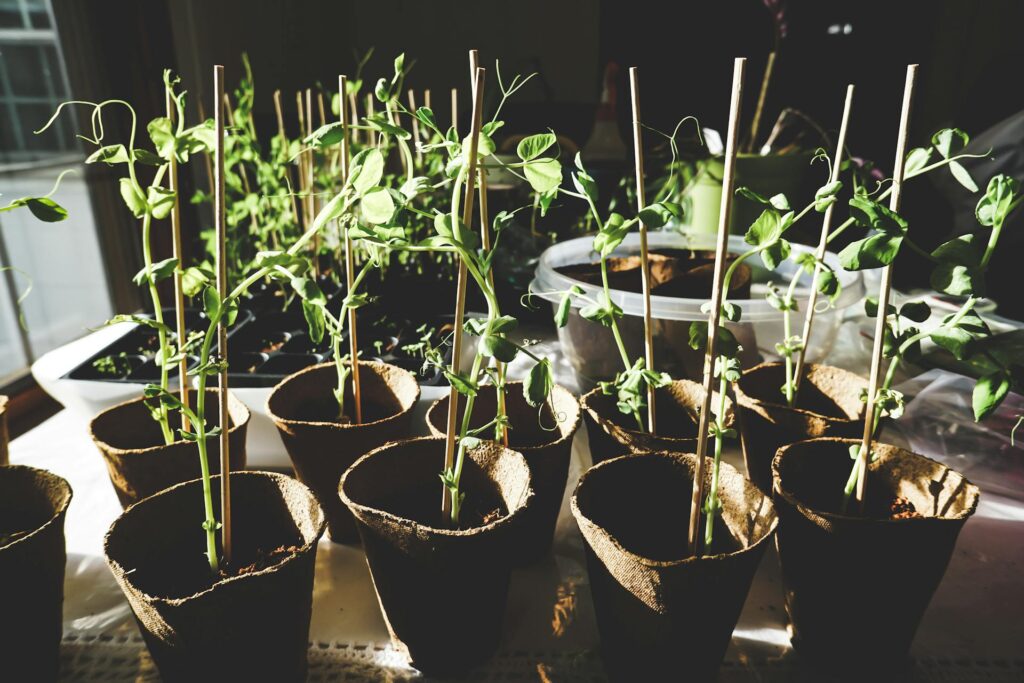
Growing vegetables in containers is the perfect solution for Florida gardeners, and these 10 varieties are proven winners in our challenging climate.
Remember, success comes from choosing the right plants, providing proper care, and learning from each growing season. Start with one or two varieties and expand as you gain confidence.
For detailed information about when to plant each vegetable throughout the year, check out our comprehensive Florida Gardening Planner. This valuable resource will help you time your plantings perfectly for optimal harvests year-round.
Before you know it, you’ll be harvesting fresh, homegrown vegetables from your own Florida container garden!
Last update on 2025-06-20 / Affiliate links / Images from Amazon Product Advertising API
This product presentation was made with AAWP plugin.













